Hello, Sign In!
LOWERING YOUR RIDE
Andy's Auto Sport receives a lot of questions regarding lowering components and how they work, so we've compiled a list of common lowering parts and their basic functions. Hopefully you will learn
a thing or two, and will have enough information to decipher some of the jargon common to the lowered suspension industry.
Methods of Lowering
Lowering Springs
Stock coil spring (left) vs. lowering spring (right)

The most common method of lowering today's vehicles is to install a set of lowering springs. These springs are generally shorter than your factory springs, but can feel softer or stiffer than stock
depending on the manufacturer and particular spring model. You see, some lowering springs are made for performance, while others may be mostly for looks (which isn't a bad thing, as some people will want to maintain
a plush factory ride). In many cases, you'll get the most benefit out of your lowered stance with the addition of performance shocks or struts, as your factory units may not work well at their new height. However,
many people do choose to retain their factory struts or shocks if the ride isn't too harsh. Lowering springs are definitely a great way to get the look and performance you want at a great pricepoint. Andy's sells
a lot of springs, so we know that a lot of people agree that they're an easy and effective way to lower your vehicle.
Drop Spindles
Factory spindle (left) vs. two-inch drop spindle (right)
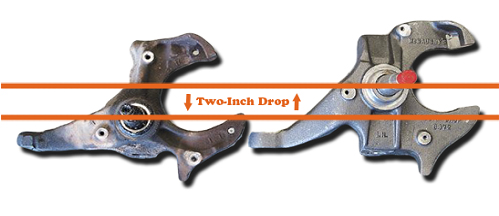
If you own a truck, SUV, or even a classic car, replacing your factory spindles with drop spindles is a great way to lower your front suspension. Drop spindles vary from stock spindles in that they are
designed with the hub mounting pins higher than the originals, which effectively lowers the vehicle without otherwise affecting the suspension geometry. Since drop spindles typically only lower a vehicle two or three
inches, many enthusiasts will combine drop spindles with lowering springs to achieve a lower stance.
Control Arms
Stock control arm (left) vs. lowered control arm (right)
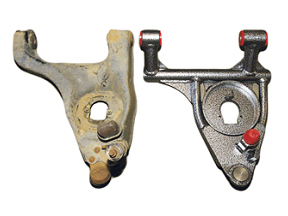
Although aftermarket lower control arms take care of lowering a vehicle by raising up the vehicle's spindle mounting points relative to the arms' spring mounts, matching them up with a proper set of
corrective aftermarket upper control arms is imperative to make sure that you can still achieve decent alignment settings. The staff at Andy's agrees that lowered control arms are an easy way to drop that truck or
muscle car of yours with minimal fuss.
Drop Beams
Stock I-beam (right) vs. drop I-beam (left)

This one applies only to the Ford folks, but we'd be remiss if we didn't mention them briefly. Lowering an old Ford is one of the toughest things to do, but thankfully companies such as Belltech and
DJM haven't given up on the task of lowering I-beam-equipped trucks. Much like drop spindles, drop beams move the hub mounting point up higher, which in turn lowers the front of your vehicle. You could use lowering
springs instead of beams, but too much of a drop on factory I-beams will yield a front suspension with way too much negative camber, which can't be corrected due to the beam's inherent design, which lacks camber
adjustment.
Lowering Blocks
Aluminum lowering block installed between leaf spring and axle pad

Lowering blocks are one of the oldest methods of lowering the rear of a vehicle - at least one of the oldest safe methods. Blocks are really simple in theory and design, acting as spacers between your
leaf springs and rear axle. Of course, lowering blocks can also double as lift blocks if your axle is located underneath your leaf springs, but we'll talk about that in another article. Lowering blocks are sometimes
available separately, although are most common in kit form with longer U-bolts and hardware. Most manufacturers offer blocks in one-inch increments, up to about four inches in height.
Shackles/Hangers
Stock shackles (left) vs. lowered shackles (right)

Stock hangers (left) vs. lowered hangers (right)
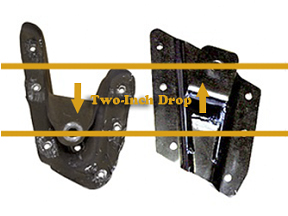
Lowered hangers and shackles can be used together or separately to relocate the mounting position of your vehicle's leaf springs to achieve a lowered stance out back. If you simply wish to level your
truck so that the rear is no longer higher than the front, adding longer lowered shackles, which attach to and swing behind the rear of the leaf spring, is a quick and easy way to achieve this goal. Hangers (the front
leaf spring mounts) are a little more involved, requiring you (or your installer) to drill out the factory hanger rivets in order to bolt on the aftermarket hangers. Some hangers actually have multiple spring holes/settings
to allow you to fine-tune your ride height as well. Shackles and hangers are available separately or as a package, so you can choose exactly how much of a drop you want.
Shackles/Hangers
Axle flip kit installed (axle was originally located underneath leaf springs)

Many trucks come equipped with the axle located underneath the leaf springs, which might make things easier if you want to lift your ride, but can make it a bear to lower properly. Luckily, we have axle flip
kits to handle the job. A flip kit essentially relocates your axle above your leaf springs, which lowers the ride height in the process, usually somewhere between five to eight inches, depending on the application. In some
cases, this can be too much of a drop for some tastes, so a set of lift shackles is sometimes included to bring the suspension back up a tiny bit.
Lowered Leaf Springs
Stock leaf spring (bottom) vs. lowered leaf spring (top)

Another way to lower the rear of your truck, SUV, or classic vehicle is to replace the factory leaf springs with lowered aftermarket leaf springs, which have less of an arch than the originals to achieve the
desired drop. This is a very straightforward installation, requiring only that you unbolt your leaf springs and bolt in the new lowered versions. Most lowered leaf springs are available with a drop between two to four inches.
A New Generation of Lowering Components
As suspension designs evolve and become increasingly more complex, new methods of lowering have become necessary to fulfill the needs of those enthusiasts who just can't stand to drive a stock vehicle. Here are some
fairly recent developments in the world of lowered vehicles:
Drop Knuckles
Stock knuckle (left) vs. drop knuckle (right)

Knuckles are just like spindles, except the center hub and wheel bearing assemblies are removable in order to have just one part number for both two and four wheel-drive trucks and SUVs, saving the vehicle manufacturer
the trouble and cost of making two different suspension components. Drop knuckles operate in the same manner as drop spindles, moving the hub mounting point higher than stock, which in turn lowers the ride height. You can expect to
find these on many newer trucks and SUVs, and are sometimes incorrectly referred to as spindles.
Lowered Ball Joints
Stock ball joint set (left) vs. lowered ball joint set (right)

Lowered ball joints move your factory knuckles or spindles up relative to the lower control arm, which lowers the ride height without affecting ride quality whatsoever. In most cases, they are paired with relocated
upper ball joints, which corrects any alignment issues and keeps both sets of control arms in the correct position.
Strut Mounts
Stock strut mount (left) vs. lowered strut mount (right)
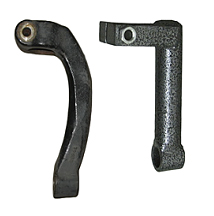
A few select applications can be lowered with shorter lower strut mounts, which reduce the amount of space between the strut and the lower control arm. We'll have to wait and see how popular these become as the years
pass, but right now they seem to be a very effective solution for the few vehicles to which they are currently applicable.
Torsion Bar Keys
Stock torsion bar key (top) vs. lowered torsion bar key (bottom)
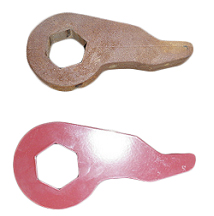
It used to be that if your vehicle came equipped with torsion bars, the only cost-effective way to lower it was to loosen up the torsion key adjustment bolts to drop the ride height. The only problem was, you couldn't
get the front end very low with the factory adjusters. Aftermarket torsion bars help cure this by re-indexing the torsion bar, thereby maintaining proper torque while still allowing a proper amount of up and down adjustment at a
lower base ride height. In essence, you can lower the front of your ride without running out of adjustment as you would with the stock keys.
Adjustable Spring Perches
Adjustable spring perch with spring
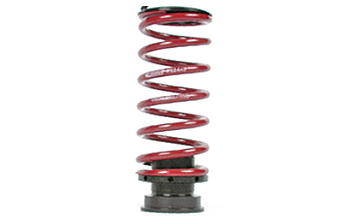
Although adjustable spring perches aren't new to the racing world, they have only recently been applied to street use, and with great success. Using the same general principle as coilovers, adjustable spring perches
combine a wide coil spring with an oversized, threaded spring perch. This setup allows a great deal of ride height adjustment without affecting spring rate, and when matched with an adjustable shock can offer a great deal of
fine-tuning for your suspension.
How Low Should I Go?
A question that we get asked often is something along the lines of, "I just bought a [insert vehicle make and model here], and I now want to lower it. How much should I lower it?" To be truthful, there are so many
variables (intended usage, tire size, owner preference) that it would be almost impossible to suggest a "one size fits all" drop, even for one particular make and model. What one person considers a mild drop might be "slammed"
to someone else, so the best thing to do is to take measurements of your vehicle from the top of your wheel arches to the center of your wheels to get a baseline, then take the drop measurements we provide in each product description
to see how much lower your ride will be compared to its existing height.
Just to get you started, here is an example of a lowered vehicle, along with the approximate amount of drop:
2009 Chevrolet Colorado, 2 inches front and rear (before and after)

Living the Low Life
Lowering your vehicle is one of the most satisfying things you can do to achieve your goals of having a truly unique ride. Aside from making your vehicle look a lot better and more aggressive, you can also often
improve handling by bringing your chassis closer to the ground. But don't forget - a lower stance means reduced road clearance, so always be a little more cautious when driving a lowered vehicle and don't hit those speed bumps too hard!
